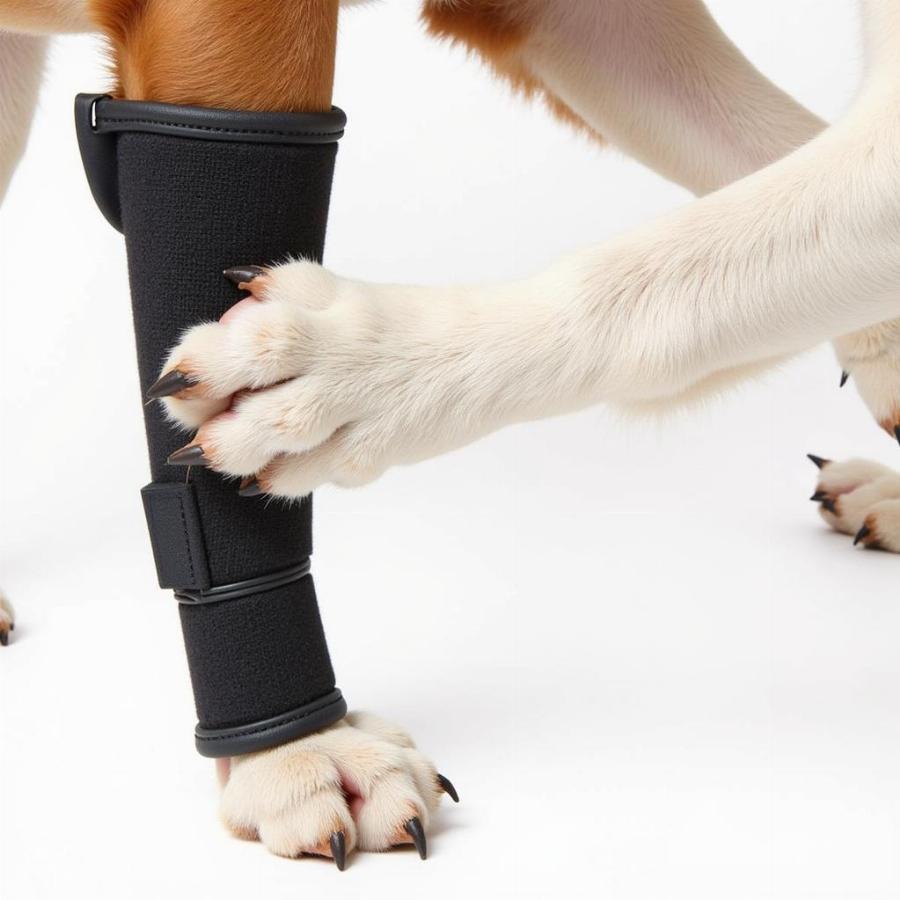Dog carpal splints can be a necessary tool in helping our furry friends recover from injuries. Whether it’s a sprain, fracture, or post-surgical support, understanding the purpose, application, and care of a carpal splint is crucial for any dog owner dealing with this issue. This article will dive deep into the world of dog carpal splints, providing you with the essential knowledge to ensure your dog’s comfort and healing.
What is a Dog Carpal Splint and Why Might My Dog Need One?
A dog carpal splint is a supportive device used to stabilize the wrist joint, known as the carpus, in dogs. It helps restrict movement, allowing injured tissues to heal properly. Several conditions can necessitate the use of a carpal splint, including sprains, strains, fractures, arthritis, and post-surgical recovery. Splints can also be used to manage hyperextension injuries or provide support for dogs with neurological conditions affecting their leg stability.
What are the signs that your dog might need a carpal splint? Lameness, swelling in the wrist area, pain upon touching the joint, and an unusual gait are all potential indicators. If you notice any of these symptoms, it’s important to consult with your veterinarian immediately. They can properly diagnose the underlying condition and determine if a carpal splint is the appropriate course of treatment.
 Applying a Dog Carpal Splint
Applying a Dog Carpal Splint
Different Types of Dog Carpal Splints and Choosing the Right One
There are various types of dog carpal splints available, ranging from pre-made options to custom-made splints designed specifically for your dog’s needs. Pre-made splints are readily available and can be a cost-effective solution for minor injuries. However, for more complex cases or dogs with unusual leg conformations, a custom-made splint crafted by a veterinarian or veterinary specialist might be necessary. Factors such as the severity of the injury, the dog’s size and breed, and the intended duration of splint wear will all play a role in choosing the right type of splint.
What materials are dog carpal splints made of? Common materials include plastic, fiberglass, and metal. Your veterinarian can recommend the most appropriate material based on your dog’s specific needs and the nature of their injury.
Applying and Caring for Your Dog’s Carpal Splint
Applying a dog carpal splint correctly is crucial for its effectiveness and your dog’s comfort. Your veterinarian will demonstrate the proper application technique and provide specific instructions for your dog’s individual needs. This might include wrapping the leg with padding before applying the splint, securing the splint with velcro straps or bandages, and ensuring that the splint isn’t too tight or too loose. splint on dog leg offers more specific insights on properly securing a splint.
Regular monitoring is essential to ensure the splint remains in place and is not causing any pressure sores or discomfort. Check the splint daily for any signs of wear and tear, and ensure that the padding underneath remains dry and clean. Your veterinarian will advise you on the frequency of splint changes and follow-up appointments. It’s important to follow their instructions carefully to promote optimal healing and prevent complications.
Living with a Carpal Splint: Tips for a Smooth Recovery
Helping your dog adjust to life with a carpal splint requires patience and understanding. Restricting your dog’s activity is crucial during the healing process. This means limiting walks, avoiding playtime with other dogs, and preventing jumping or running. Providing a comfortable and supportive resting area is also essential. Consider using orthopedic beds or extra padding to ensure your dog’s comfort.
“Encouraging your dog to rest and keeping them calm is key to a successful recovery,” advises Dr. Emily Carter, DVM. “Short, leash-controlled walks are permissible, but avoid any strenuous activity.”
Remember, a carpal splint is a temporary measure to aid healing. With proper care and attention, your furry friend can return to their normal activities in time.
Dr. Sarah Mitchell, a certified veterinary rehabilitation specialist, adds, “Regular physical therapy exercises, as prescribed by your veterinarian, can significantly improve your dog’s recovery time and mobility.” You can find more helpful tips on our article about splint on dog leg.
Conclusion
A dog carpal splint can be an invaluable tool in helping your dog recover from a variety of wrist injuries. By understanding the different types of splints available, the proper application and care techniques, and how to manage your dog’s activity during recovery, you can ensure the best possible outcome for your furry companion. Always consult with your veterinarian for a proper diagnosis and personalized treatment plan, including the use and management of a carpal splint. By working closely with your vet and following their instructions, you can help your dog regain their mobility and enjoy a happy, healthy life.
FAQs about Dog Carpal Splints
- How long will my dog need to wear a carpal splint?
- Can my dog sleep with a carpal splint on?
- How do I clean my dog’s carpal splint?
- What are the signs of a splint-related complication?
- Are there any alternatives to carpal splints for wrist injuries in dogs?
- How much does a dog carpal splint cost?
- Can my dog swim with a carpal splint?
Further Reading
- Caring for a Dog with a Broken Leg
- Understanding Canine Arthritis
- Dog First Aid Basics
Beaut Dogs is your go-to resource for all things related to canine care, offering expert advice and valuable insights into the world of dogs. From breed information to health and wellness tips, we provide a comprehensive platform for dog lovers everywhere. For personalized guidance and support, don’t hesitate to contact us at [email protected]. We’re here to help you and your furry friend live a happy, healthy life together. Visit us at https://beautdogs.com for more information.